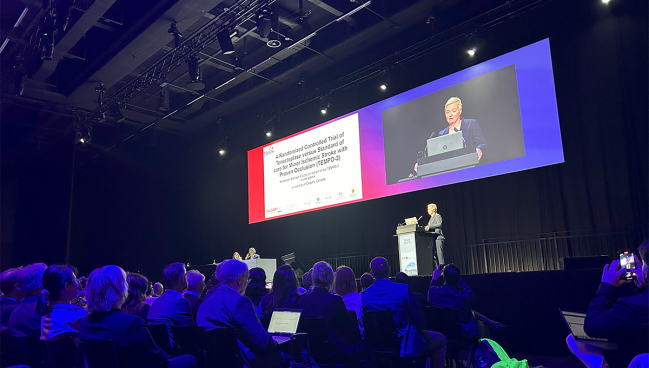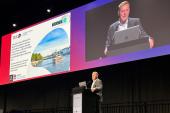TEMPO-2: Tenecteplase No Help in Mild Stroke With Proven Occlusion
A lack of benefit—and possible harm—means tenecteplase shouldn’t be given routinely in this population, researchers say.

BASEL, Switzerland—Tenecteplase doesn’t seem to be a good option for patients with mild, nondisabling ischemic strokes, even when they have a proven intracranial occlusion, according to the results of the TEMPO-2 trial.
Despite having a higher rate of recanalization, those treated with the thrombolytic were no more likely to return to baseline neurological functioning by 90 days than were those who received standard care (72% vs 75%), which was mostly dual antiplatelet therapy (DAPT), Shelagh Coutts, MD (Hotchkiss Brain Institute, University of Calgary, Canada), reported last week at the European Stroke Organisation Conference (ESOC) 2024.
Moreover, the rate of 90-day death was higher in the tenecteplase arm (5% vs 1%), show the findings, which were published simultaneously online in the Lancet.
“There was no benefit and possibly harm in nondisabling minor stroke patients with intracranial occlusion treated with intravenous tenecteplase,” Coutts said, adding that these types of patients “should not be routinely treated with tenecteplase.”
A Different Population for Tenecteplase
In recent years, evidence has been mounting in support of tenecteplase as a safe and effective IV thrombolytic option alongside alteplase for patients with moderate-to-severe, disabling ischemic strokes—a trajectory supported by several other ESOC trials in the acute stroke setting. However, Coutts said, many physicians have been concerned that the risks of thrombolysis—ie, bleeding—outweigh any potential benefits in patients with minor strokes.
Two prior trials—PRISMS and ARAMIS—failed to show that IV thrombolysis improved outcomes over antiplatelet therapy in patients with mild, nondisabling strokes. But neither focused on the higher-risk subgroup of patients with intracranial occlusion or used tenecteplase, which has some advantages over alteplase, primarily a longer half-life that allows for single-bolus administration rather than delivery with a 1-hour infusion.
To address those gaps, TEMPO-2 investigators tested whether IV tenecteplase would be superior to standard-of-care antiplatelet therapy in patients with minor ischemic strokes accompanied by intracranial occlusions or focal perfusion abnormalities on brain imaging. The trial, conducted at 48 hospitals in Australia, Austria, Brazil, Canada, Finland, Ireland, New Zealand, Singapore, Spain, and the United Kingdom, enrolled patients who had a prestroke modified Rankin Scale (mRS) score of 0 to 2, had an NIHSS score of 0 to 5 and an ASPECTS greater than 6 at presentation, didn’t have extensive ischemia, and could be treated within 12 hours of when they were last seen well.
The trial was stopped early for futility after 886 patients (median age 72; 42% women) had been randomized to IV tenecteplase or standard care, which included DAPT with aspirin and clopidogrel in 57% and aspirin alone in 23%. The median time from stroke onset to randomization was 4.6 hours. The median NIHSS score was 2.
The primary outcome was a return to baseline neurological functioning according to the mRS score at 90 days. There was no significant difference between the tenecteplase and control arms (risk ratio 0.96; 95% CI 0.88-1.04).
There was no benefit and possibly harm in nondisabling minor stroke patients with intracranial occlusion treated with intravenous tenecteplase. Shelagh Coutts
Secondary outcomes also generally showed no differences between groups, although the proportion of patients who had an NIHSS score of 0 at 5 days or discharge was higher among those treated with tenecteplase (57% vs 50%; RR 1.16; 95% CI 1.02-1.31).
Safety favored antiplatelet therapy, however. At 90 days, the risk of death was higher in the tenecteplase-treated patients (HR 3.8; 95% CI 1.4-10.2). Although seven deaths (six with tenecteplase and one with standard therapy) were related to symptomatic intracranial hemorrhage (sICH), most occurred late after treatment and were not deemed to be related to thrombolysis, Coutts said.
There were more cases of sICH in the tenecteplase arm than in the control arm, although the difference was not statistically significant (eight vs two cases; P = 0.059). The rate was low overall, and “this is not the explanation for the null result” of the trial, Coutts said.
In a subgroup analysis of 515 patients who had direct evidence of an occlusion at baseline and underwent a follow-up scan, the overall rate of recanalization was higher with tenecteplase versus antiplatelet therapy (48% vs 22%; P < 0.001), with consistent results among those with large-vessel occlusions and medium-vessel occlusions. Coutts pointed out that the control group largely received DAPT, which “is a very active treatment that we know improves outcomes. And it may be that this difference is not big enough to [influence] outcomes in this population.”
Door Not Closed Yet
Commenting for TCTMD, Mark Parsons, MD, PhD (University of New South Wales, Sydney, Australia), a TEMPO-2 investigator, said the trial was testing the concept that IV thrombolysis might be useful in the subset of patients with so-called minor strokes who are at risk for early clinical deterioration based on the presence of an intracranial occlusion.
Although the main trial result failed to show that tenecteplase was beneficial, it could be that using more advanced imaging might still identify a subgroup of patients who require more aggressive treatment with IV thrombolysis, Parsons said, noting that perfusion CT scans were not performed in the vast majority of patients in TEMPO-2.
In particular, he said, “my feeling is that the perfusion imaging helps you decide which patients might be at a higher or lower risk of bleeding.”
As to whether this is the end of the story for IV thrombolysis in mild stroke, Parsons said: “I’m not 100% sure, but this study certainly won’t convince anybody to change practice to giving thrombolysis to patients with mild stroke at this point in time. But I think there’s still scope for looking at this group with more advanced imaging.”
Todd Neale is the Associate News Editor for TCTMD and a Senior Medical Journalist. He got his start in journalism at …
Read Full BioSources
Coutts SB, Ankolekar S, Appireddy R, et al. Tenecteplase versus standard of care for minor ischaemic stroke with proven occlusion (TEMPO-2): a randomized, open label, phase 3 superiority trial. Lancet. 2024;Epub ahead of print.
Disclosures
- Coutts received grant funding from the Canadian Institutes of Health Research, the Heart and Stroke Foundation of Canada, and the British Heart Foundation to complete the TEMPO-2 study. Boehringer Ingelheim provided off-the-shelf study drug (tenecteplase) for the study.
- Parsons is on the Boehringer Ingelheim advisory board for Metalyse in stroke.





Comments